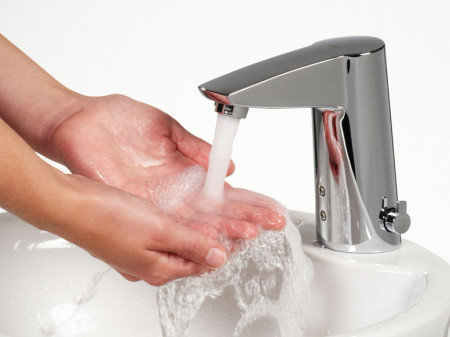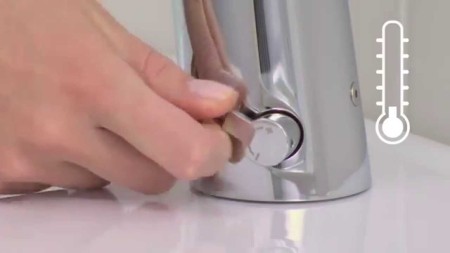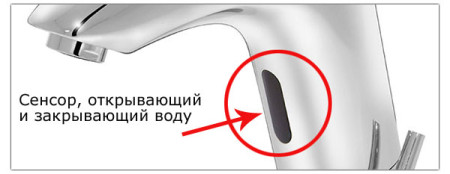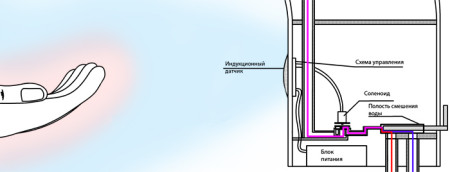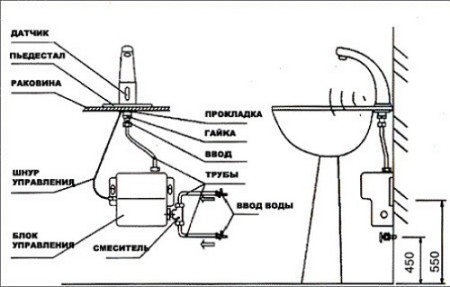Once upon a time ordinary faucet mixers were replaced by more convenient lever valves, and now, thanks to the development of technical progress, there were mixers without handles and levers, so-called sensor mixers.
Content
Touch the tap, what is it?
Manufacturers of equipment constantly invent and offer consumers all new devices that make a person's life more comfortable and at the same time allow more economical use of expensive today's electricity, gas and water.
Sensor mixers lack the usual external controls responsible for the supply of water, they independently feed and close the water when approaching and removing hands. Instead of handles and levers in front there is a small window behind which a sensitive sensor is placed. The principle of operation of these mixers is that the water opens only for a time when the person's hands are in the area of the sensor, so that the consumption of cold and hot water decreases significantly.
To operate contactless faucets is very simple: in order for water to flow, it's enough to just put your hands up. Sensory mixers are often called automatic because of their ability to automatically open and close the water supply.
As a rule, a small lever is placed on the side of the mixer, which makes it possible to regulate the temperature of the outflowing water.
In addition to the usual housing, the mixer has a control unit with a valve, which is installed separately and connected to the housing by means of flexible hoses for water and electric wires.
The electric part of the mixer can be conditionally divided into two parts: a control circuit with a sensitive sensor and an executive part with a solenoid valve. Sensory mixers have similar in performance water-blocking devices, but various in principle the operation of their control system. The water supply is controlled by sensors with high sensitivity. These can be motion detectors that track the movement of an object, induction sensors that monitor the change in the electromagnetic field, capacitive sensors that capture the increase or decrease of the summing capacitance, and some other types of sensors.
The valve controlling the supply of water is designed in such a way that it is opened and held in this state only when the supply voltage is applied to it. Thus, in the event of any malfunctions associated with the interruption of the supply circuit, or when the batteries are discharged, the membrane will immediately fall and block the water.
The battery status indication in different models is realized in different ways. Their discharge can be signaled by a flashing LED, in some models the signaling about the need to replace the batteries manifests itself in the form of a pulsating stream of water.
On sale are as simple budget mixers with a minimum set of functions, and expensive branded multifunctional devices with a remote control. Thanks to the electronic control of automatic mixers, the most diverse and sometimes unexpected options are inherent:
- the inclusion of water in the presentation of hands to the device;
- turn on the mode of continuous water supply;
- change the response time and turn off when approaching and removing hands;
- adjustment of sensitivity and sensor operating distance;
- automatic adaptation of the sensor to changes in external conditions;
- automatic sensor focusing;
- automatic water shut-off after a predetermined time interval;
- setting a water flow limitation;
- adjustment of water temperature;
- maintaining the set water temperature with the built-in thermostat;
- monitoring the battery status;
- control by remote or integrated control panel;
- manual shut-off of the water supply for cleaning the sink;
- automatic thermal disinfection;
- automatic hygienic flushing after a long break in operation, etc.
Depending on the model, each of the many mixers produced has, to a greater or lesser degree, one of the functions listed above, and you can select the product that is most suitable for the cost, design, and set of options that can be performed.
How to choose a touch mixer
To select a sensor mixer, consider the following points.
- It is worth paying attention to the fact that there are devices with mixing and without mixing water. Hot and cold water are connected to the first ones, which are mixed in the device. The temperature of the leaking water is regulated by a small lever on the side of the faucet. Only cold, hot or pre-mixed water is supplied to the mixer without mixing.
- Like conventional mixers, automatic can have flexible or rigid water connections.
- The spout of the mixer may have a different shape and size, which must be taken into account when installing in a particular location.
- There are often cases when it takes a long time to drain warm water to reach the desired temperature, or water supply, especially to the upper floors of multi-storey buildings, is interrupted. Sensory mixers are very inconvenient to operate under such conditions, therefore it is recommended to install them only in water supply networks that correspond to all norms of temperature, pressure, water quality, etc.
- A set of some expensive luxury models of automatic mixers may include a remote control that allows you to implement advanced settings of the device.
- Operation of the automatic mixer is not possible without power supply. Depending on the model of the device it can be carried out:
- from an alternating current network through a step-down transformer or a pulse converter;
- from replaceable batteries;
- from an alternating current network and replaceable batteries at the same time.
Each of these options has its advantages and disadvantages.
Operation of mixers with mains power does not require periodic replacement of batteries, however, during installation it is not always possible to connect to the existing wiring or to lay an electric wire. Therefore, if it is not possible to supply power, then mixers with mains power should not be used. If repairs are carried out and the installation of such a device is planned, it is necessary in advance to take care of laying an additional wire.
Mixers with autonomous power supply are free from this drawback, however, from time to time replacement of the batteries is necessary. To be fair, it should be noted that pulse control schemes for the operation of the valve are now widely used, which have low power consumption and significantly increase the service life of the batteries. The more often a mixer is used, the more often the batteries need to be changed. For power supply in different models different power sources with different capacities are used. In the responses to the sensor mixers, you can find information that some models of devices can work for up to five years, subject to the use of quality batteries. In addition, in terms of electrical safety, the use of battery devices is more preferable.
Pros and cons of sensor mixers
dignity:
- convenience and ease of use of the device;
- high hygiene;
- significant water saving;
- large range of settings;
- safety of use.
limitations:
- the price of automatic mixers is much higher than usual;
- the need for wire routing for devices with mains power and battery replacement for devices with autonomous power;
- the need to install quality water filters and control their purity;
- mixing of water occurs before the closing valve, so it is necessary to install check valves for hot and cold water;
- inconvenience, if necessary, to collect a large volume of water;
- inability to adjust the head of water;
- because during the preparation of food and washing dishes used water of different temperatures, when placing the mixer in the kitchen it is impossible to provide completely contactless control.
Install a touch-sensitive mixer with your own hands, useful tips
The installation of an automatic mixer differs somewhat from the installation of a conventional mixer. Installation of the device should begin with the shutoff of the water supply, so as not to flood its rooms and premises of neighbors. The kit includes the necessary mounting parts, as well as a passport or instruction manual for installation and installation, which details the order of performance of work for a particular model.
In the upper part of the sink there is a landing hole where a mixer is inserted through the mounting gasket and fixed with a nut. A gasket and a metal plate are placed under the nut.
There are several versions of the mixer, so the installation of different devices may differ slightly from each other. The solenoid valve that controls the water supply can be installed inside the mixer or delivered to the control unit. In the first case, the control unit is connected to the valve inside the mixer housing by the control wire, and in the second - the control unit with the valve is connected to the mixer body by flexible hoses.
A significant difference between automatic mixers and conventional ones is the availability of the first control unit with a solenoid valve, which is attached under the sink in a convenient place. To the mixer with mains power supply it is necessary to lay the power cord, observing the electrical safety measures. After fixing the mixer and the control unit, it is connected to the water pipes, turning on the water supply and checking the functioning.
Below are detailed examples of the installation of various options for contactless faucets.
Features in operation of sensor mixers
The valve membrane is highly susceptible to contamination, often due to poor water quality. If the water does not overlap completely when using the device, disassemble the mixer and clean the rubber membrane. In order not to clean the appliance too often, it is recommended to use mixers with a microfilter only.
When using sensor mixers from time to time, their incorrect operation may be detected. This is mainly due to the ingress of dirt or drops onto the window behind which the sensor is placed, and is eliminated by cleaning the window. In addition, the shell is a kind of concave mirror and with a certain mutual arrangement of the shell and the light source, the rays from the latter can be focused on the sensor, thereby disrupting the normal operation of the automatic mixer. In this case, it is recommended to try to transfer the light source to another place, to eliminate the direct rays on the shell or to change the sensitivity of the sensor.
The entry into the field of action of the automatic mixer sensor of any objects will not lead to uncontrolled water intake, which potential customers of these devices are afraid of. When the object moves, the locking valve opens, however, the algorithm of the device operation is such that after a certain time the water will be blocked, since the movement of the object will cease. In addition, many of the mixers are automatically disconnected automatically after a specified time.
Sensory mixers are perfect for forgetful people, they will save the apartment from flooding, automatically turning off the water after a specified period of time.
Sensory mixers have both advantages and disadvantages. The most ideal area of application is public places where they are installed exclusively for washing the visitors' hands, or the bathroom washbasin. In kitchen conditions, automatic cranes are not very convenient, because it is often necessary that water flows regardless of the person's hands in front of the sensor. On the other hand, such devices allow to save considerably on the payment of constantly rising public utilities, therefore it is up to the owners to decide whether or not to install this equipment at home.



